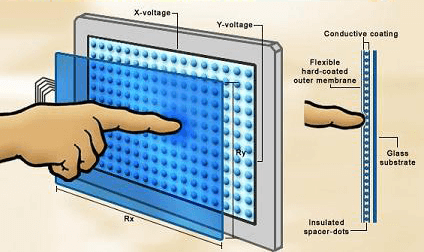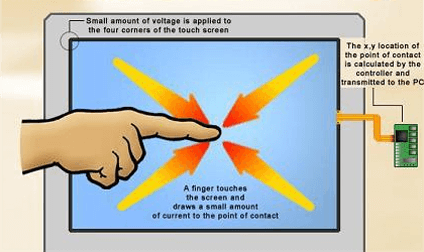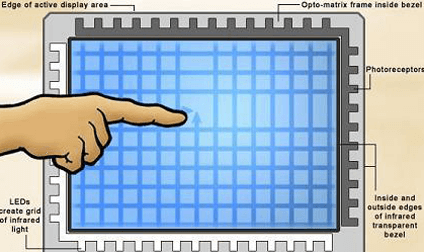Touch Technology
DisplayBoost’s advanced touch technology works with adhesives, optical bonding, and is even waterproof. It adapts seamlessly to any system and creates a user-friendly experience that enables both workers and customers to find what they need quickly and easily.

How Resistive Touchscreens Work
Resistive Touch Technology:
Resistive technology starts with two layers being joined together. A hard-coated ITO is layered over a conductive clear glass, which are held apart by spacers. The flexible layer gently touches the second layer, and the voltage is detected and measured. An advanced controller calculates the position of the touch by measuring voltage from along the X-Y axis. The advantage of resistive technology is its affordability, but the panel cannot sustain strong punches or work in harsh environments.

How Capacitive Touchscreens Work
Surface Capacitive Touch Technology:
Surface Capacitive Touch Technology (SCAP) applies an electrical charge to the four corners of a conducive glass coating. The charge spreads along an X-Y axis to create a stable voltage that won’t degrade with time. Anytime a user touches the screen, a little bit of the voltage transfers directly to them. The controller recognizes the difference in voltage as a touch and sends the X-Y axis information to the PC port. Capacitive technology’s big advantage is that it transmits as much as 90% percent of the light from the screen, which means it’s more efficient than resistive technology.

How Capacitive Touchscreens Work
Projected Capacitive Touch Technology:
Projected Capacitive (PCAP) Touch and Surface Capacitive Touch share one key similarity. They use ITO coatings for both the X and Y-axis. The difference occurs during calibration. Projected capacitive touch ITO is modeled after individual pads that wire as X and Y arrays, meaning it delivers touch coordination without requiring calibration. Because of this, PCAP allows a cover lens on the surface of your display, which can aid in applications that need a flat surface or complete seal. It also supports multi-touch.

How Infra-Red Touchscreens Work
Infrared (IR) Touch Technology:
For infrared touch technology to work, the touch panels need infrared receivers and CRT utilizing infrared Light Emitting Diodes (LED) along the horizontal and vertical X-Y axis. When the screen detects a touch, the infrared light discharged by the LED beam is broken. The X-Y axis delivers information via the receiver which then lands in your PC port.
For more information on our touch technology, please contact us. We’ll help you achieve the perfect display solution to fit your needs. If customization isn’t for you, we also offer a list of high quality, affordable, standard products ready to ship.













